ABDOMINAL TRAUMA Rambam Medical Center Dr Nordkin Dmitri

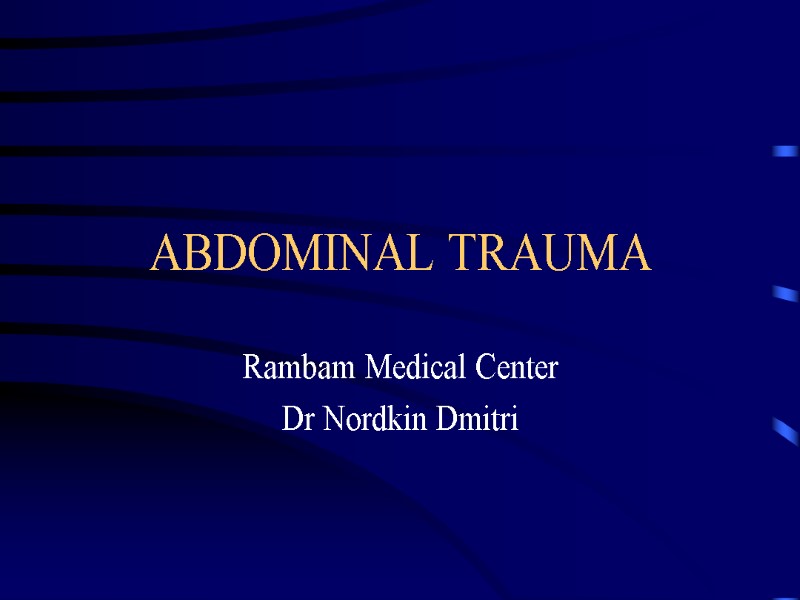
ABDOMINAL TRAUMA Rambam Medical Center Dr Nordkin Dmitri
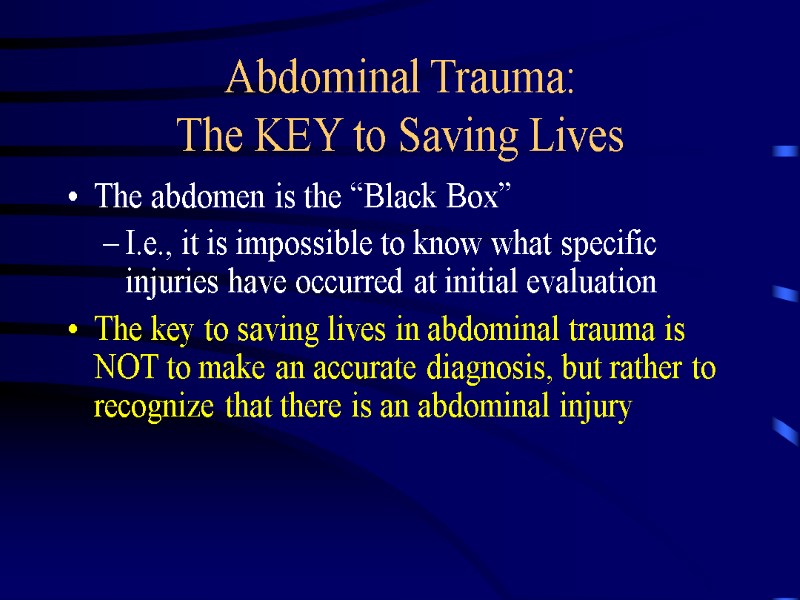
Abdominal Trauma: The KEY to Saving Lives The abdomen is the “Black Box” I.e., it is impossible to know what specific injuries have occurred at initial evaluation The key to saving lives in abdominal trauma is NOT to make an accurate diagnosis, but rather to recognize that there is an abdominal injury
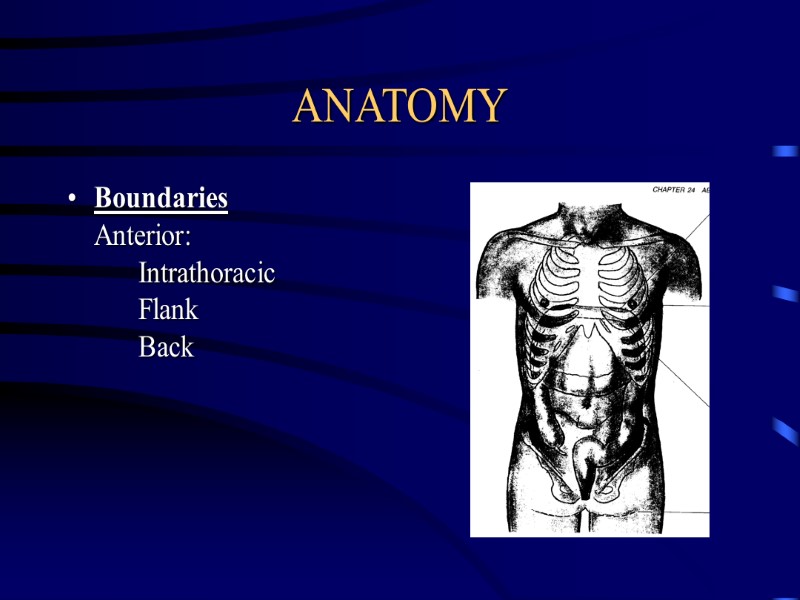
ANATOMY Boundaries Anterior: Intrathoracic Flank Back
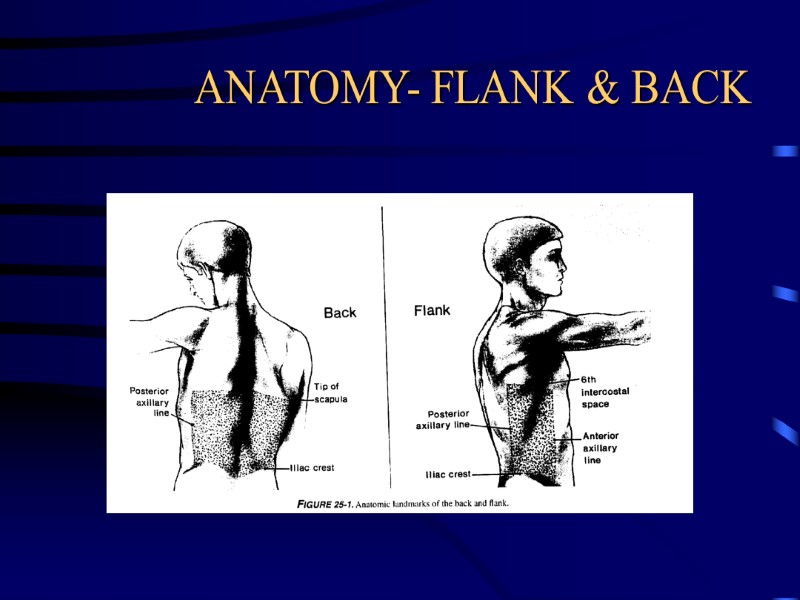
ANATOMY- FLANK & BACK
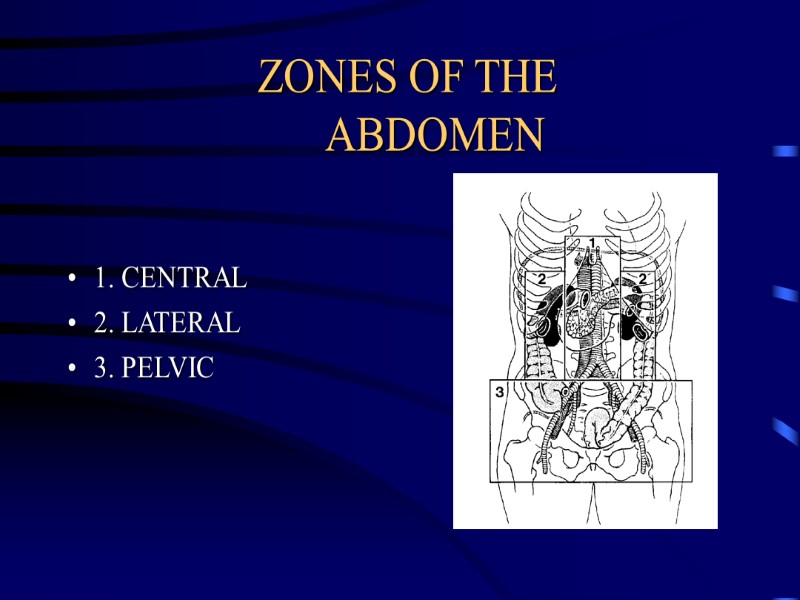
ZONES OF THE ABDOMEN 1. CENTRAL 2. LATERAL 3. PELVIC
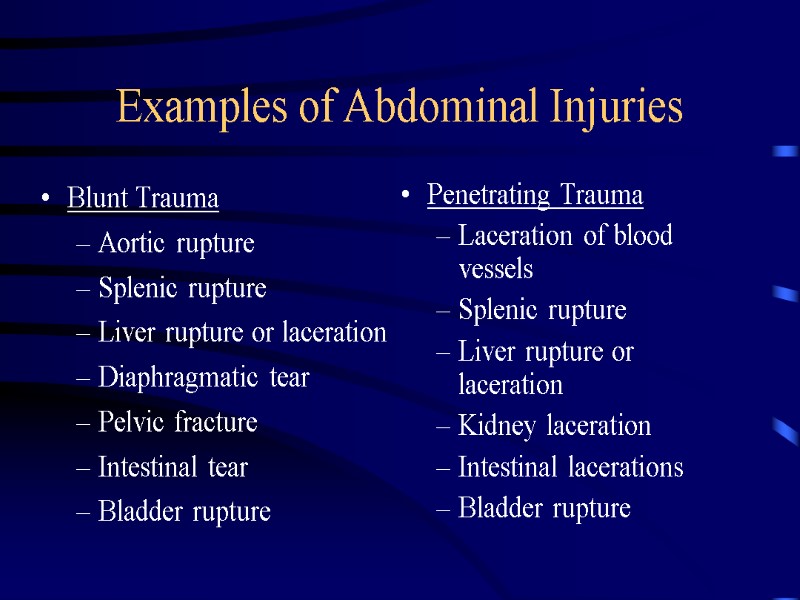
Examples of Abdominal Injuries Blunt Trauma Aortic rupture Splenic rupture Liver rupture or laceration Diaphragmatic tear Pelvic fracture Intestinal tear Bladder rupture Penetrating Trauma Laceration of blood vessels Splenic rupture Liver rupture or laceration Kidney laceration Intestinal lacerations Bladder rupture
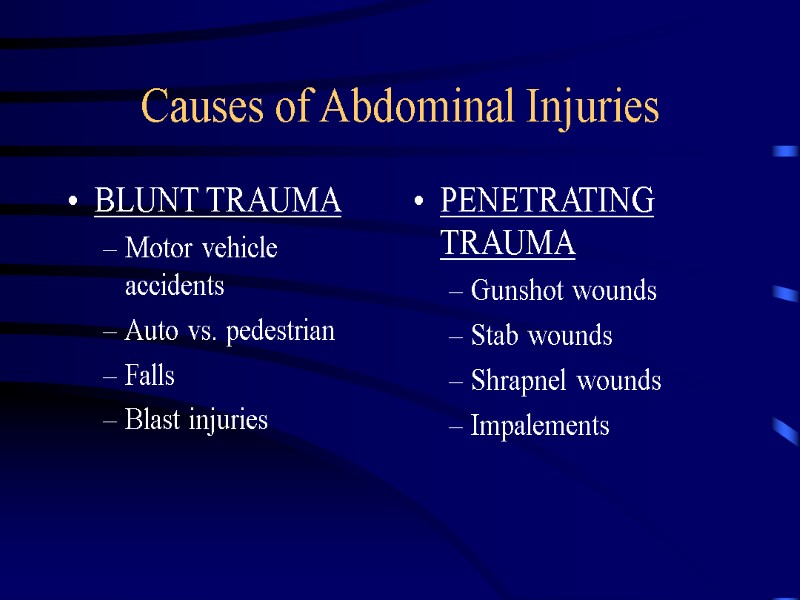
Causes of Abdominal Injuries BLUNT TRAUMA Motor vehicle accidents Auto vs. pedestrian Falls Blast injuries PENETRATING TRAUMA Gunshot wounds Stab wounds Shrapnel wounds Impalements
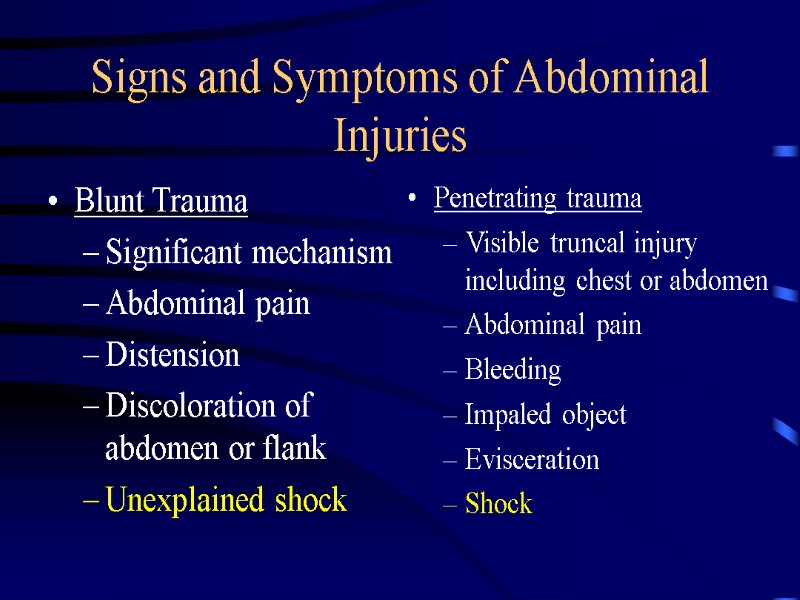
Signs and Symptoms of Abdominal Injuries Blunt Trauma Significant mechanism Abdominal pain Distension Discoloration of abdomen or flank Unexplained shock Penetrating trauma Visible truncal injury including chest or abdomen Abdominal pain Bleeding Impaled object Evisceration Shock
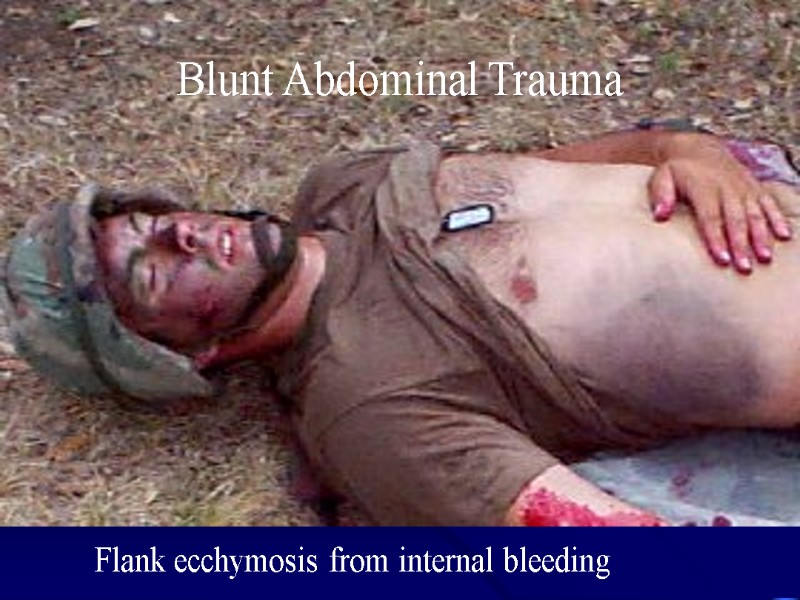
Blunt Abdominal Trauma Flank ecchymosis from internal bleeding
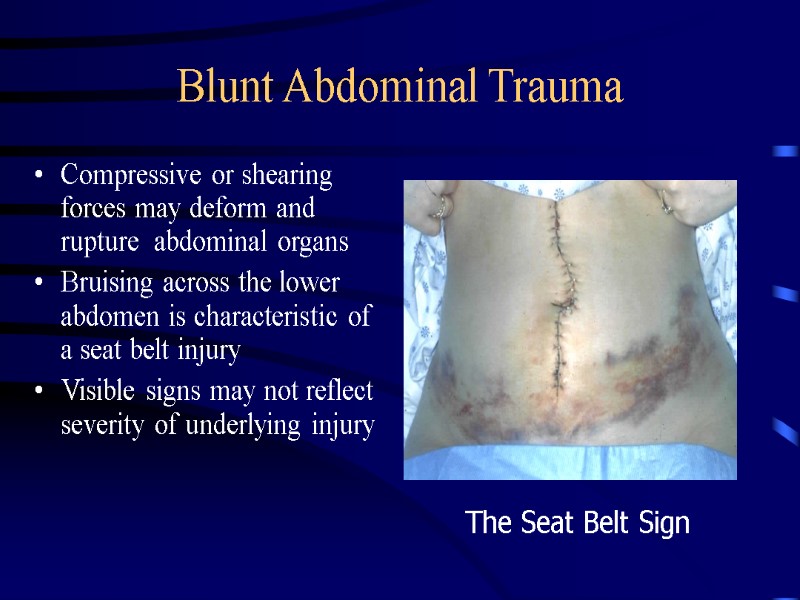
Blunt Abdominal Trauma Compressive or shearing forces may deform and rupture abdominal organs Bruising across the lower abdomen is characteristic of a seat belt injury Visible signs may not reflect severity of underlying injury The Seat Belt Sign
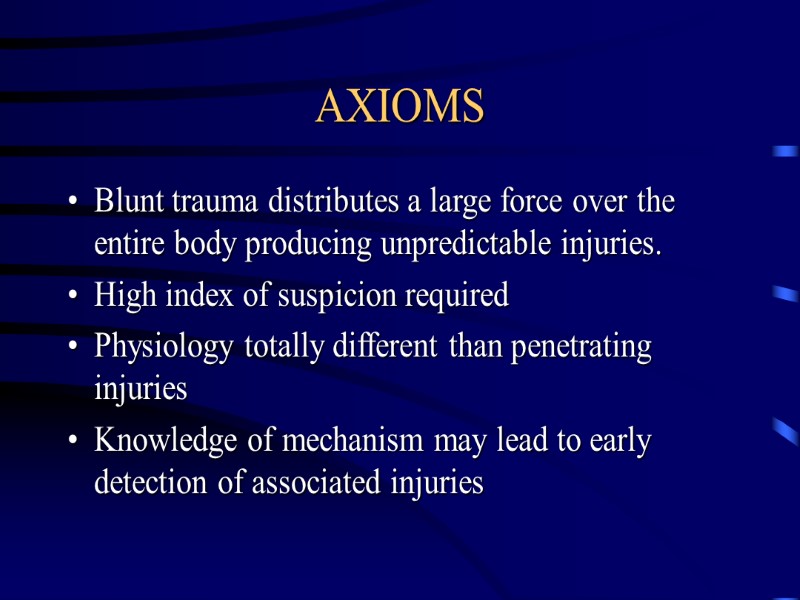
AXIOMS Blunt trauma distributes a large force over the entire body producing unpredictable injuries. High index of suspicion required Physiology totally different than penetrating injuries Knowledge of mechanism may lead to early detection of associated injuries
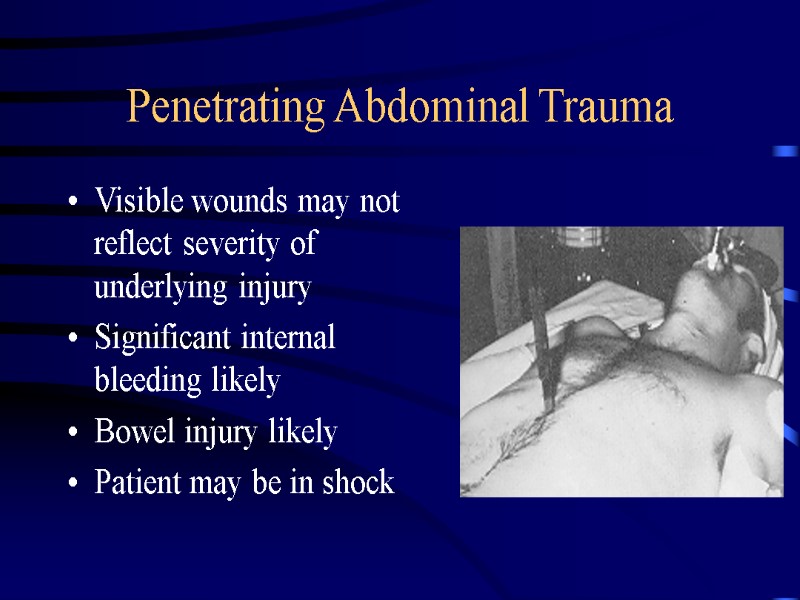
Penetrating Abdominal Trauma Visible wounds may not reflect severity of underlying injury Significant internal bleeding likely Bowel injury likely Patient may be in shock
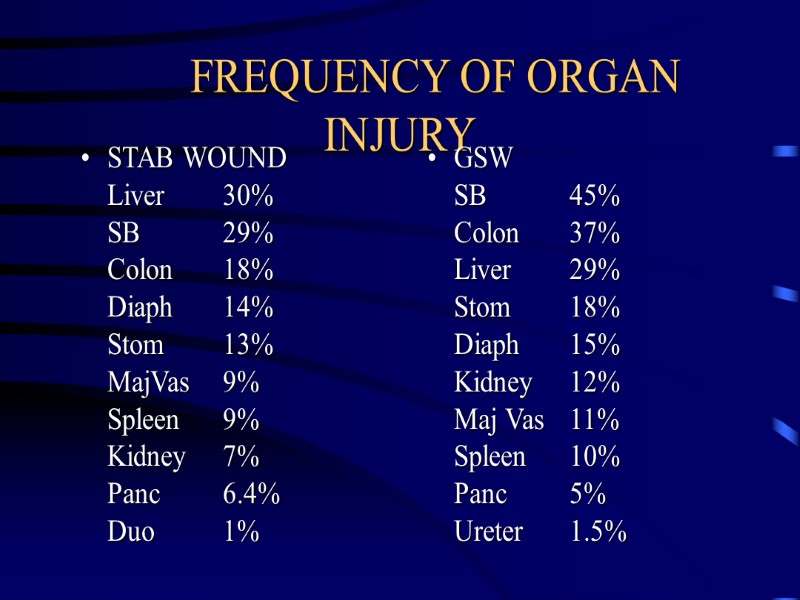
FREQUENCY OF ORGAN INJURY STAB WOUND Liver 30% SB 29% Colon 18% Diaph 14% Stom 13% MajVas 9% Spleen 9% Kidney 7% Panc 6.4% Duo 1% GSW SB 45% Colon 37% Liver 29% Stom 18% Diaph 15% Kidney 12% Maj Vas 11% Spleen 10% Panc 5% Ureter 1.5%
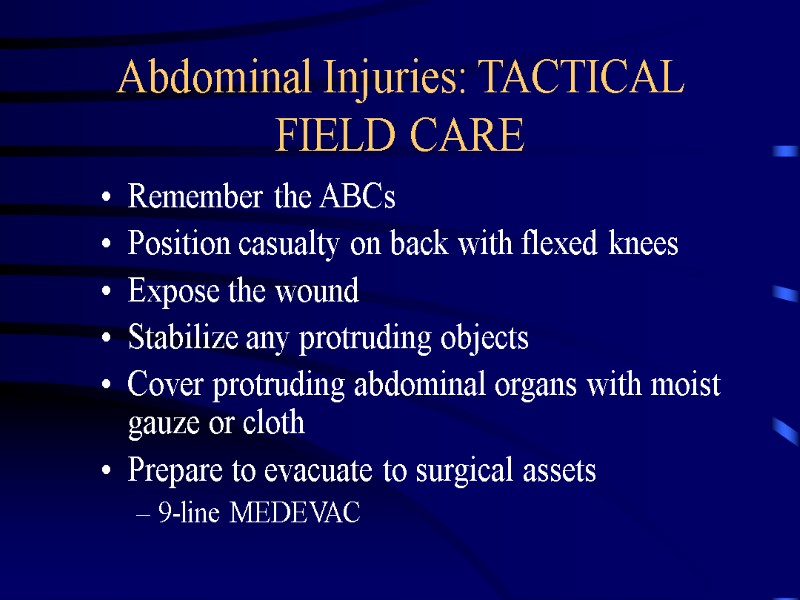
Abdominal Injuries: TACTICAL FIELD CARE Remember the ABCs Position casualty on back with flexed knees Expose the wound Stabilize any protruding objects Cover protruding abdominal organs with moist gauze or cloth Prepare to evacuate to surgical assets 9-line MEDEVAC
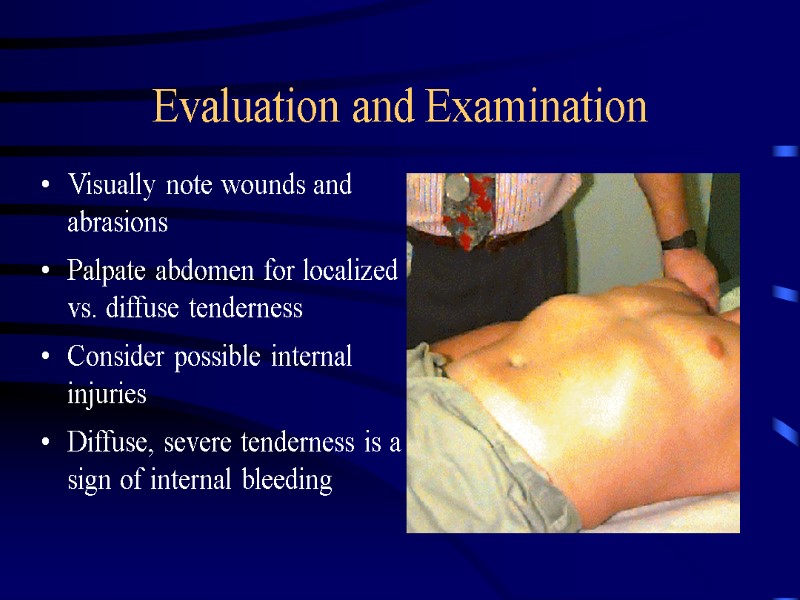
Evaluation and Examination Visually note wounds and abrasions Palpate abdomen for localized vs. diffuse tenderness Consider possible internal injuries Diffuse, severe tenderness is a sign of internal bleeding

Don’t forget the back Turn the casualty over when you can do so safely Visually inspect back Palpate ribs, spine, sacrum for tenderness and irregularities Dress the wound with an occlusive dressing Don’t count on a “down-side sweep” to discover injuries this size
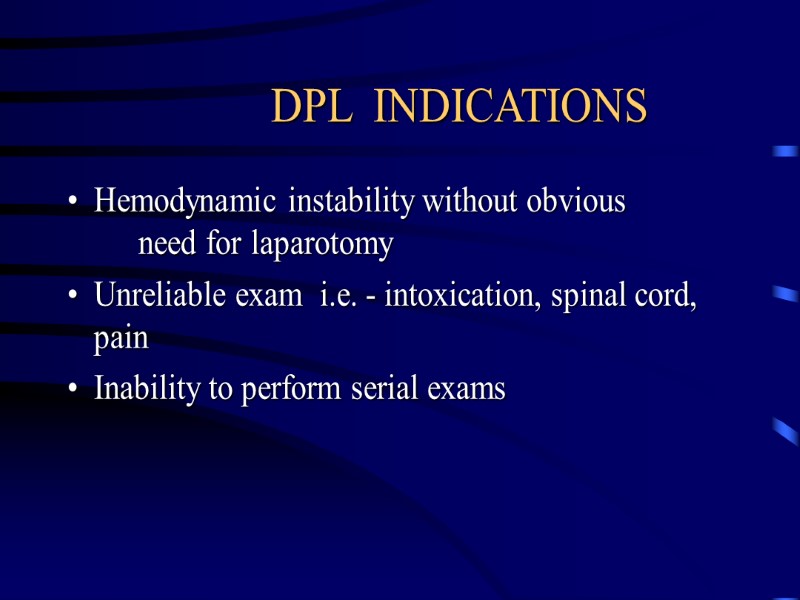
DPL INDICATIONS Hemodynamic instability without obvious need for laparotomy Unreliable exam i.e. - intoxication, spinal cord, pain Inability to perform serial exams
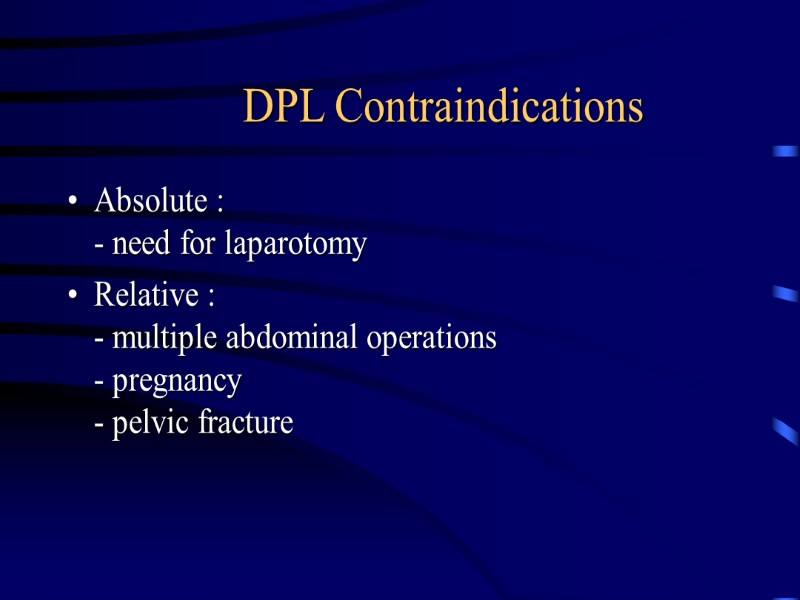
DPL Contraindications Absolute : - need for laparotomy Relative : - multiple abdominal operations - pregnancy - pelvic fracture
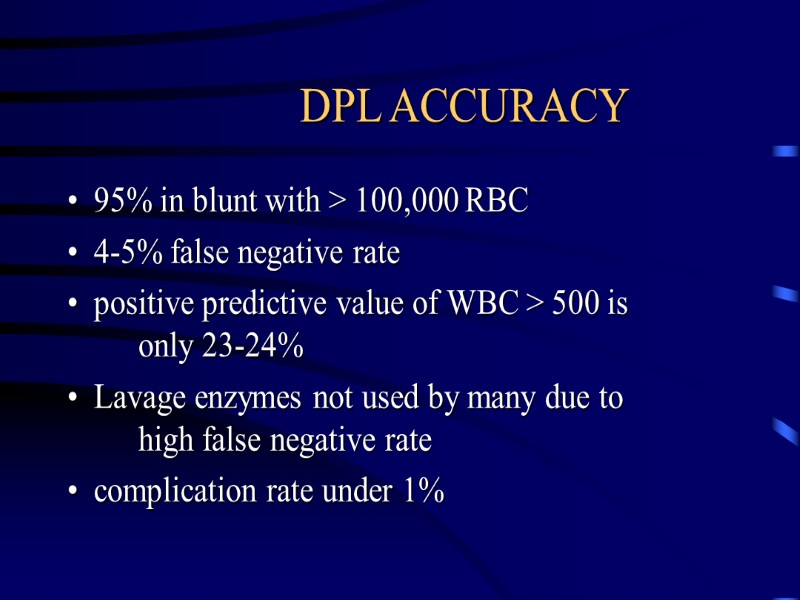
DPL ACCURACY 95% in blunt with > 100,000 RBC 4-5% false negative rate positive predictive value of WBC > 500 is only 23-24% Lavage enzymes not used by many due to high false negative rate complication rate under 1%
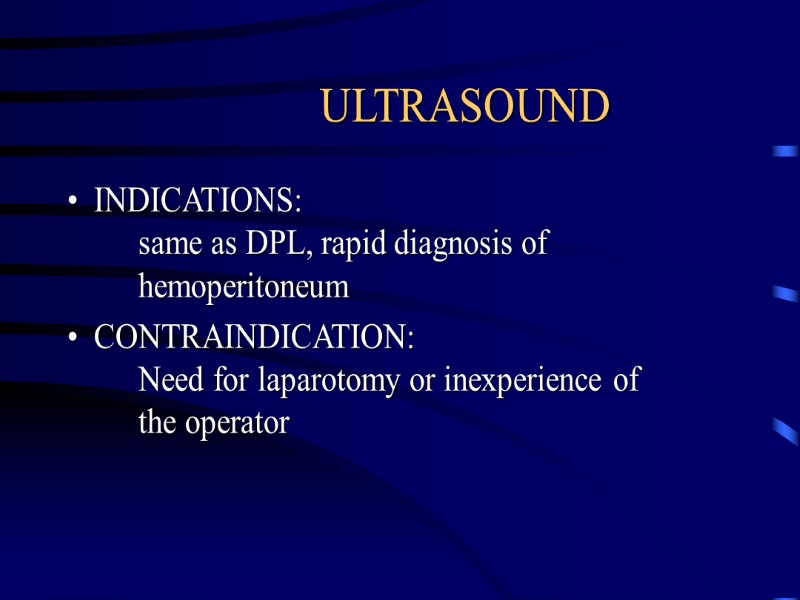
ULTRASOUND INDICATIONS: same as DPL, rapid diagnosis of hemoperitoneum CONTRAINDICATION: Need for laparotomy or inexperience of the operator
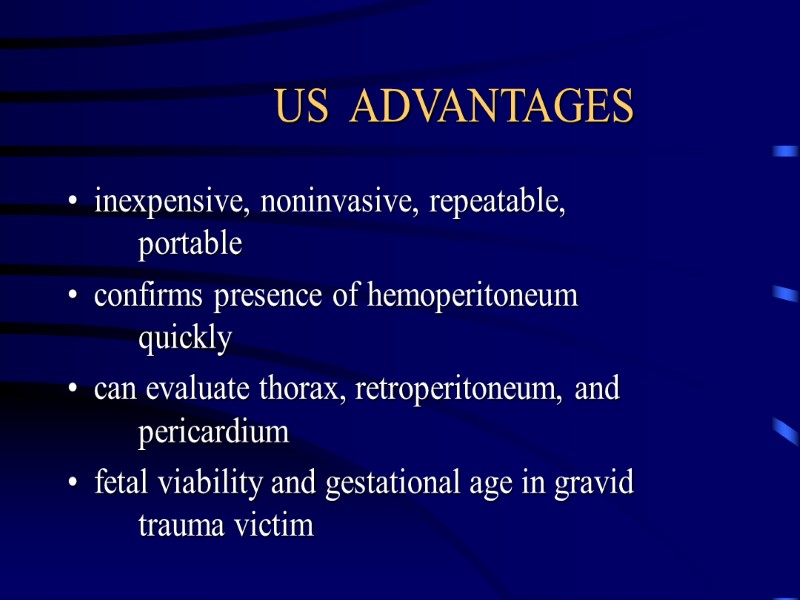
US ADVANTAGES inexpensive, noninvasive, repeatable, portable confirms presence of hemoperitoneum quickly can evaluate thorax, retroperitoneum, and pericardium fetal viability and gestational age in gravid trauma victim
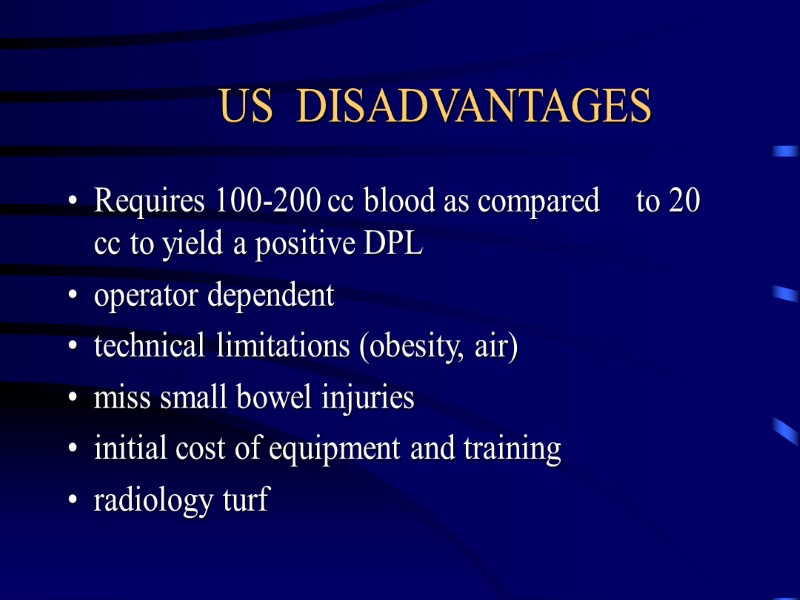
US DISADVANTAGES Requires 100-200 cc blood as compared to 20 cc to yield a positive DPL operator dependent technical limitations (obesity, air) miss small bowel injuries initial cost of equipment and training radiology turf

US ACCURACY Sensitivity 70-90% -operator dependent -requires minimum of 100-200 cc fluid -obesity and sub-q emphysema - does not detect SB injury well Specificity 60-90%
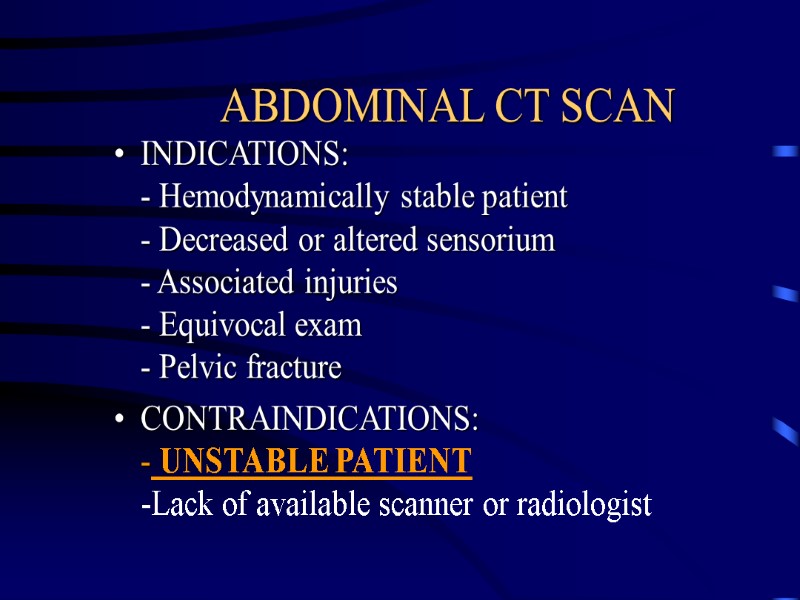
ABDOMINAL CT SCAN INDICATIONS: - Hemodynamically stable patient - Decreased or altered sensorium - Associated injuries - Equivocal exam - Pelvic fracture CONTRAINDICATIONS: - UNSTABLE PATIENT -Lack of available scanner or radiologist
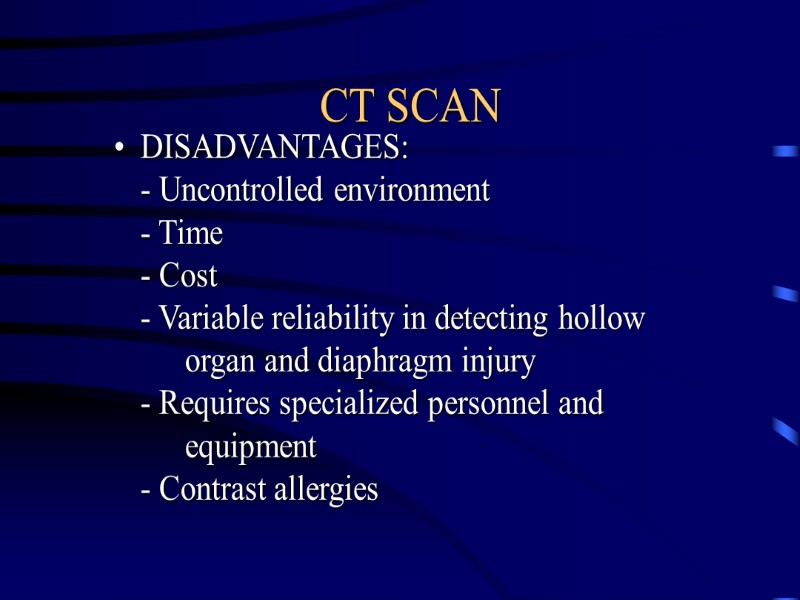
CT SCAN DISADVANTAGES: - Uncontrolled environment - Time - Cost - Variable reliability in detecting hollow organ and diaphragm injury - Requires specialized personnel and equipment - Contrast allergies
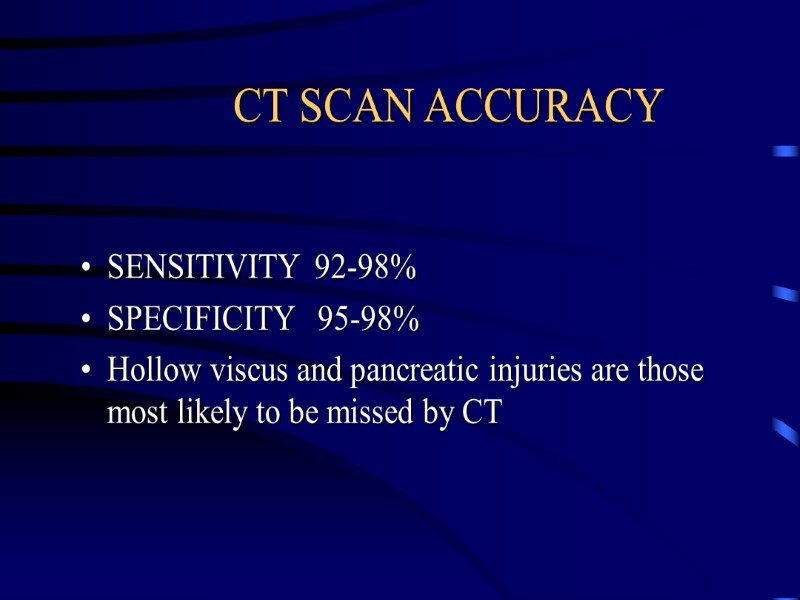
CT SCAN ACCURACY SENSITIVITY 92-98% SPECIFICITY 95-98% Hollow viscus and pancreatic injuries are those most likely to be missed by CT
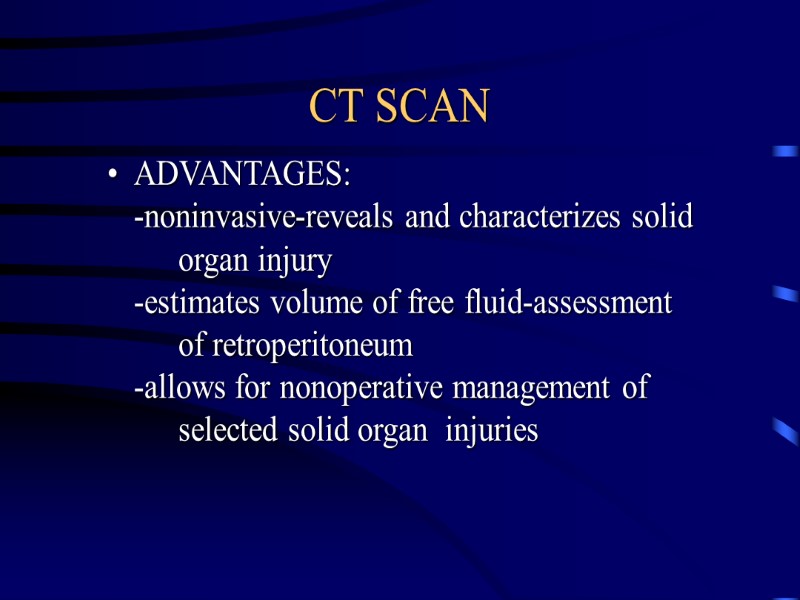
CT SCAN ADVANTAGES: -noninvasive-reveals and characterizes solid organ injury -estimates volume of free fluid-assessment of retroperitoneum -allows for nonoperative management of selected solid organ injuries
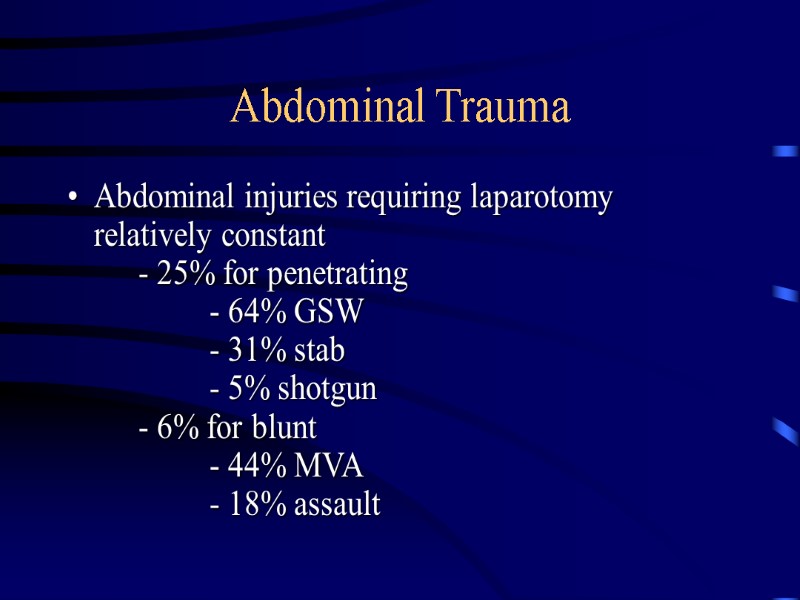
Abdominal Trauma Abdominal injuries requiring laparotomy relatively constant - 25% for penetrating - 64% GSW - 31% stab - 5% shotgun - 6% for blunt - 44% MVA - 18% assault
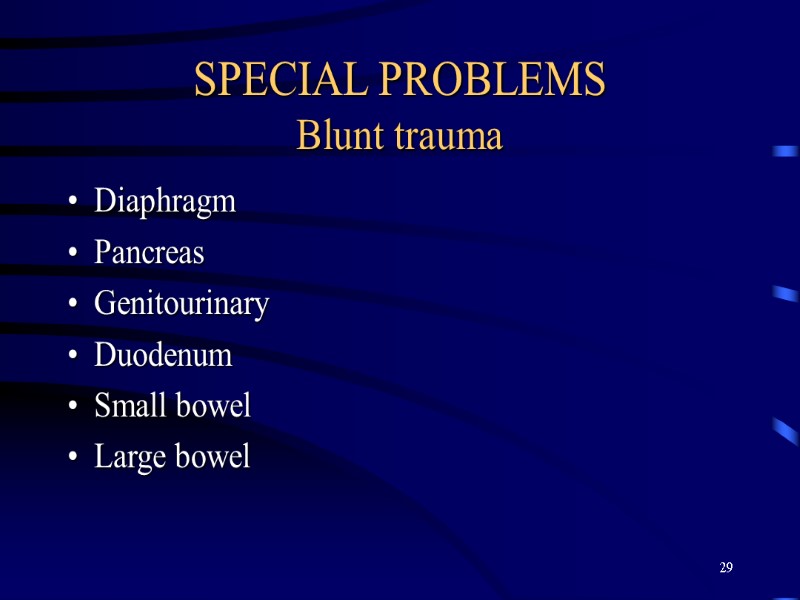
29 SPECIAL PROBLEMS Blunt trauma Diaphragm Pancreas Genitourinary Duodenum Small bowel Large bowel
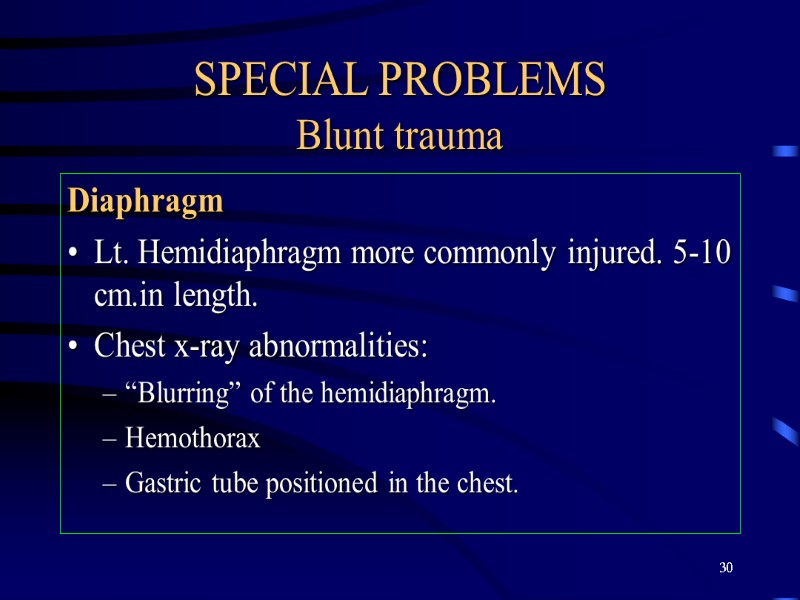
30 SPECIAL PROBLEMS Blunt trauma Diaphragm Lt. Hemidiaphragm more commonly injured. 5-10 cm.in length. Chest x-ray abnormalities: “Blurring” of the hemidiaphragm. Hemothorax Gastric tube positioned in the chest.

31
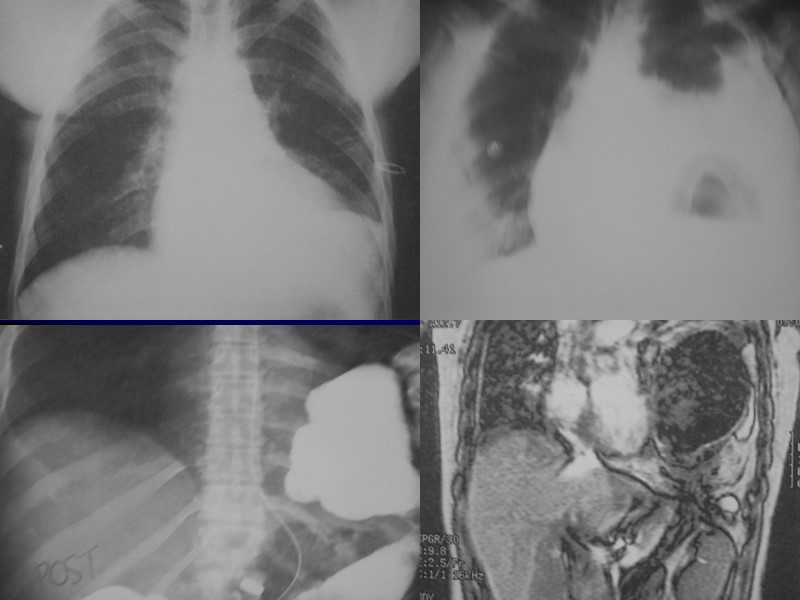
32
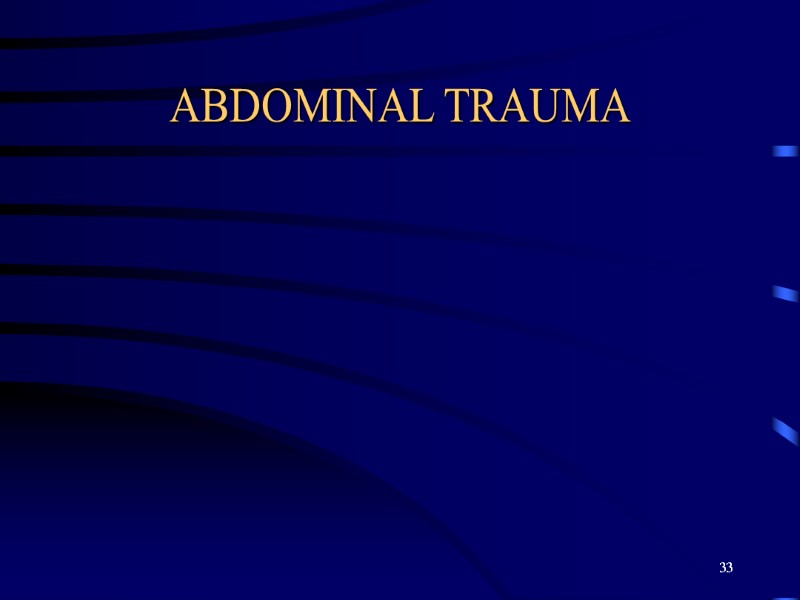
33 ABDOMINAL TRAUMA
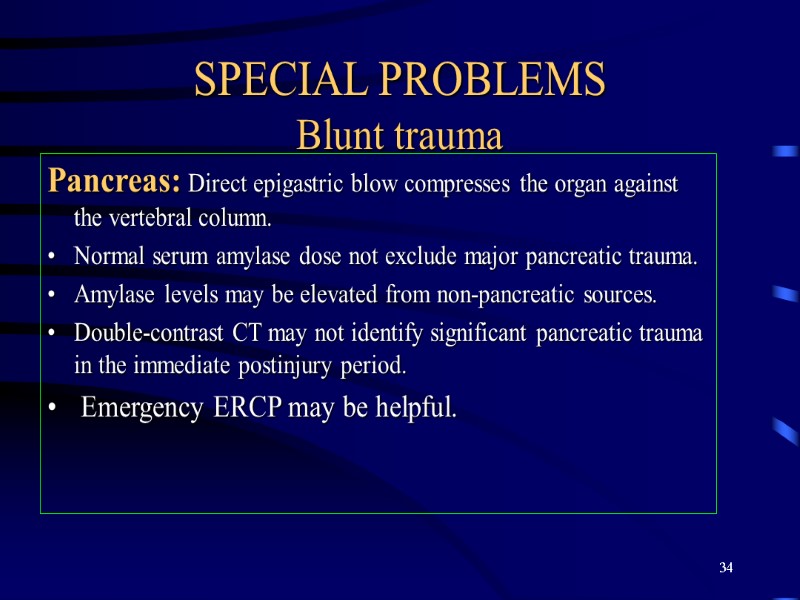
34 SPECIAL PROBLEMS Blunt trauma Pancreas: Direct epigastric blow compresses the organ against the vertebral column. Normal serum amylase dose not exclude major pancreatic trauma. Amylase levels may be elevated from non-pancreatic sources. Double-contrast CT may not identify significant pancreatic trauma in the immediate postinjury period. Emergency ERCP may be helpful.
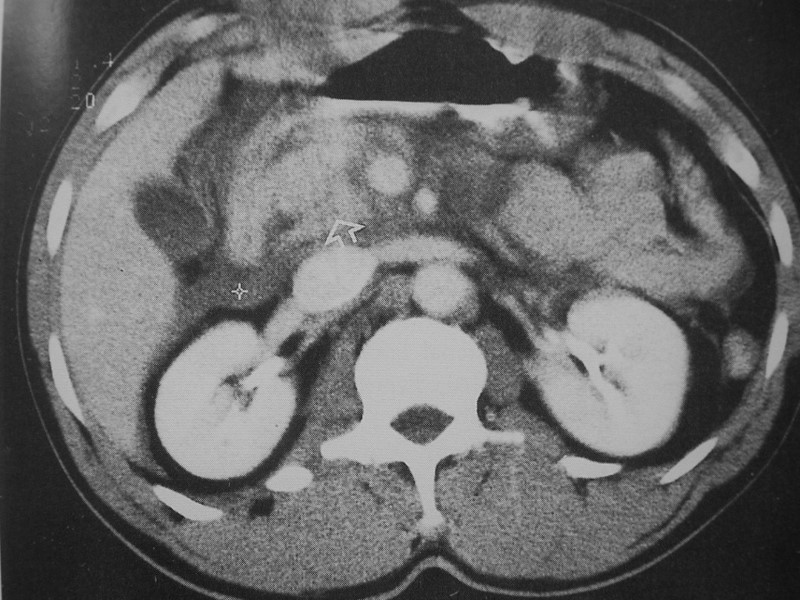
35
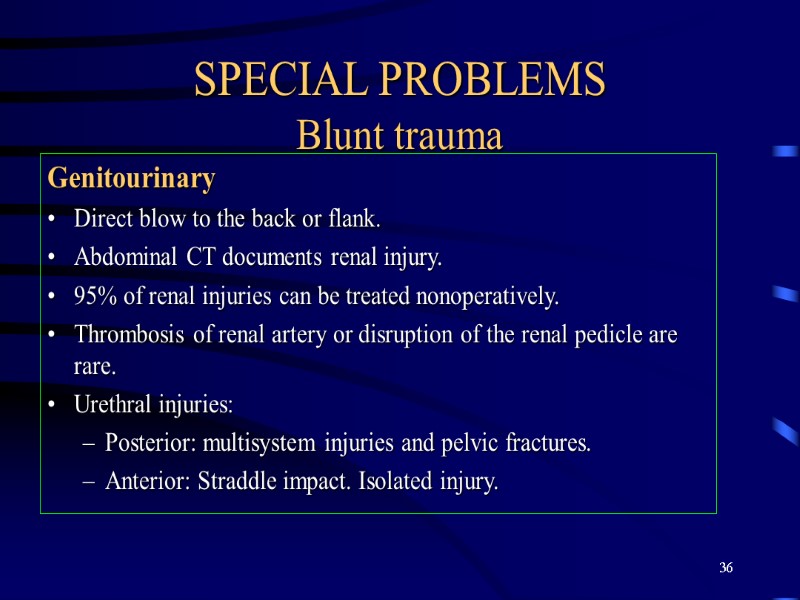
36 SPECIAL PROBLEMS Blunt trauma Genitourinary Direct blow to the back or flank. Abdominal CT documents renal injury. 95% of renal injuries can be treated nonoperatively. Thrombosis of renal artery or disruption of the renal pedicle are rare. Urethral injuries: Posterior: multisystem injuries and pelvic fractures. Anterior: Straddle impact. Isolated injury.
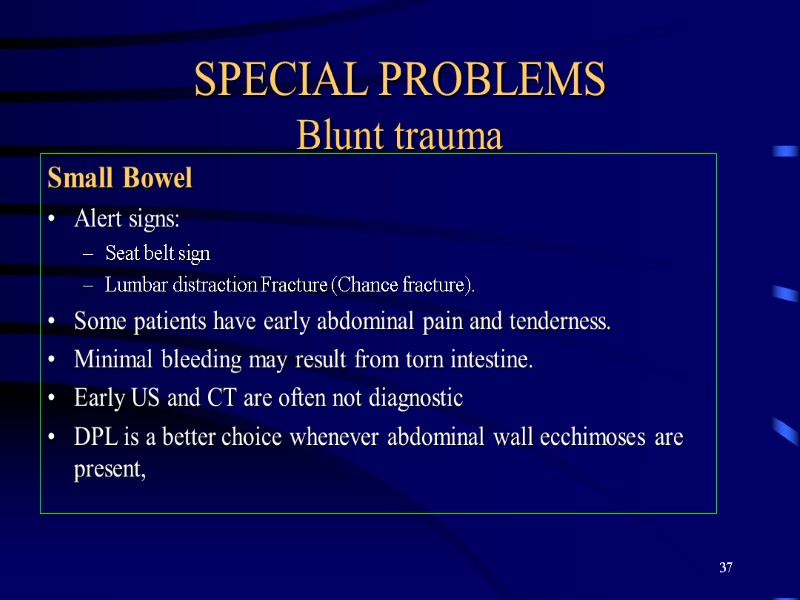
37 SPECIAL PROBLEMS Blunt trauma Small Bowel Alert signs: Seat belt sign Lumbar distraction Fracture (Chance fracture). Some patients have early abdominal pain and tenderness. Minimal bleeding may result from torn intestine. Early US and CT are often not diagnostic DPL is a better choice whenever abdominal wall ecchimoses are present,
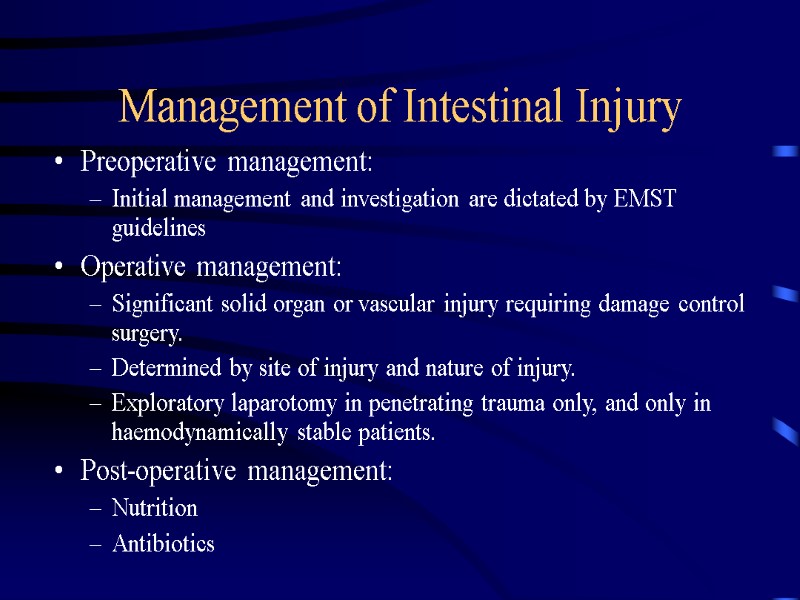
Management of Intestinal Injury Preoperative management: Initial management and investigation are dictated by EMST guidelines Operative management: Significant solid organ or vascular injury requiring damage control surgery. Determined by site of injury and nature of injury. Exploratory laparotomy in penetrating trauma only, and only in haemodynamically stable patients. Post-operative management: Nutrition Antibiotics
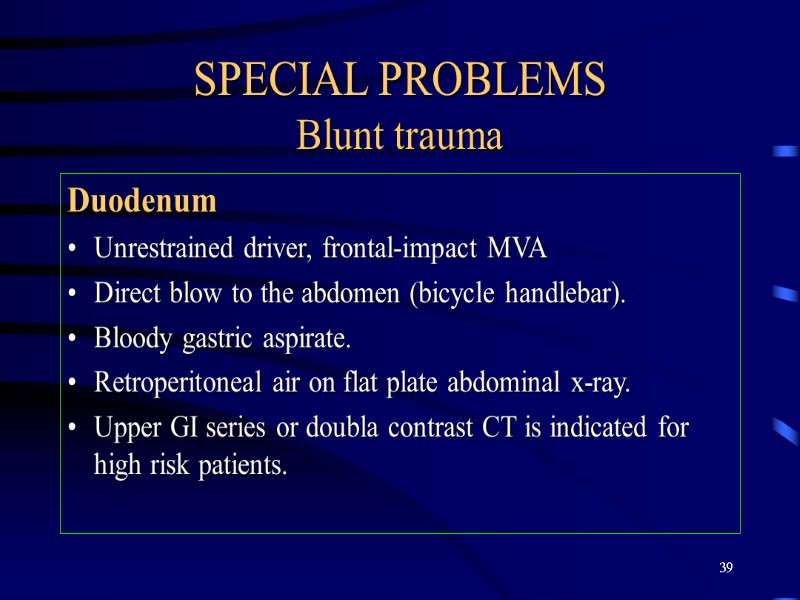
39 SPECIAL PROBLEMS Blunt trauma Duodenum Unrestrained driver, frontal-impact MVA Direct blow to the abdomen (bicycle handlebar). Bloody gastric aspirate. Retroperitoneal air on flat plate abdominal x-ray. Upper GI series or doubla contrast CT is indicated for high risk patients.
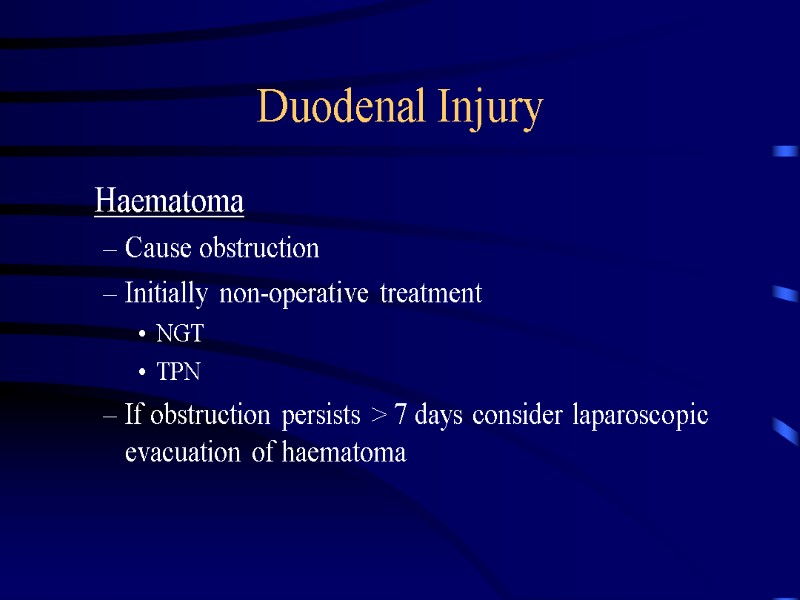
Duodenal Injury Haematoma Cause obstruction Initially non-operative treatment NGT TPN If obstruction persists > 7 days consider laparoscopic evacuation of haematoma
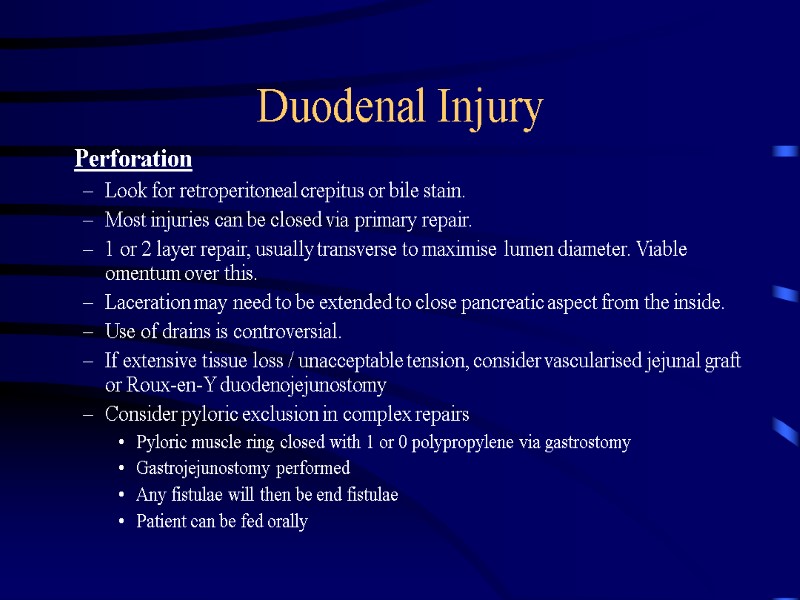
Duodenal Injury Perforation Look for retroperitoneal crepitus or bile stain. Most injuries can be closed via primary repair. 1 or 2 layer repair, usually transverse to maximise lumen diameter. Viable omentum over this. Laceration may need to be extended to close pancreatic aspect from the inside. Use of drains is controversial. If extensive tissue loss / unacceptable tension, consider vascularised jejunal graft or Roux-en-Y duodenojejunostomy Consider pyloric exclusion in complex repairs Pyloric muscle ring closed with 1 or 0 polypropylene via gastrostomy Gastrojejunostomy performed Any fistulae will then be end fistulae Patient can be fed orally
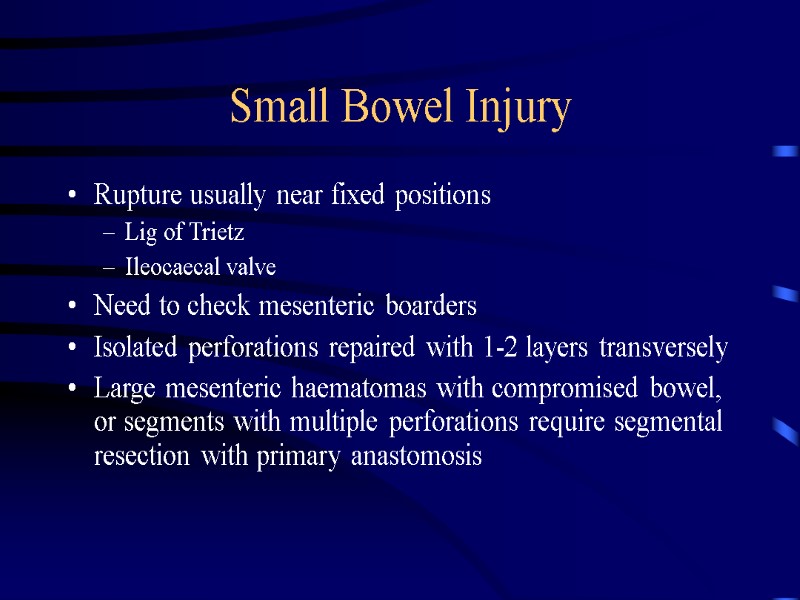
Small Bowel Injury Rupture usually near fixed positions Lig of Trietz Ileocaecal valve Need to check mesenteric boarders Isolated perforations repaired with 1-2 layers transversely Large mesenteric haematomas with compromised bowel, or segments with multiple perforations require segmental resection with primary anastomosis
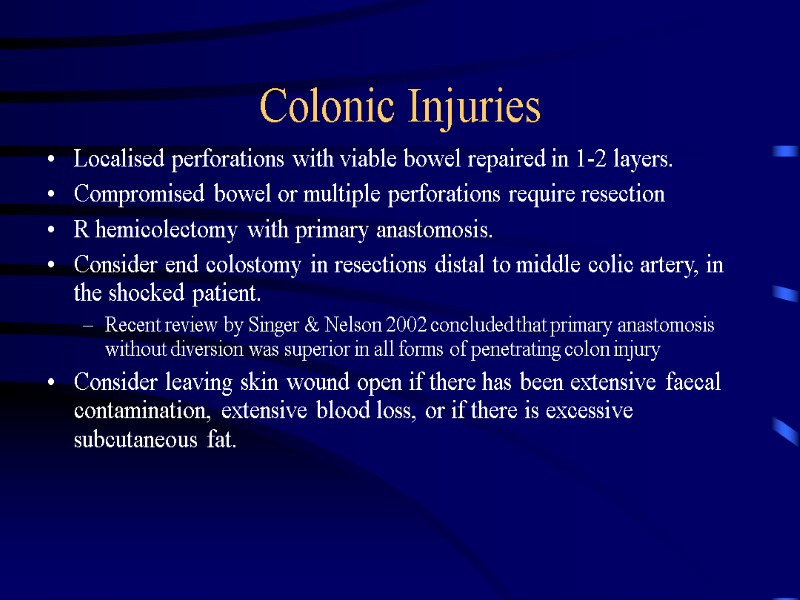
Colonic Injuries Localised perforations with viable bowel repaired in 1-2 layers. Compromised bowel or multiple perforations require resection R hemicolectomy with primary anastomosis. Consider end colostomy in resections distal to middle colic artery, in the shocked patient. Recent review by Singer & Nelson 2002 concluded that primary anastomosis without diversion was superior in all forms of penetrating colon injury Consider leaving skin wound open if there has been extensive faecal contamination, extensive blood loss, or if there is excessive subcutaneous fat.
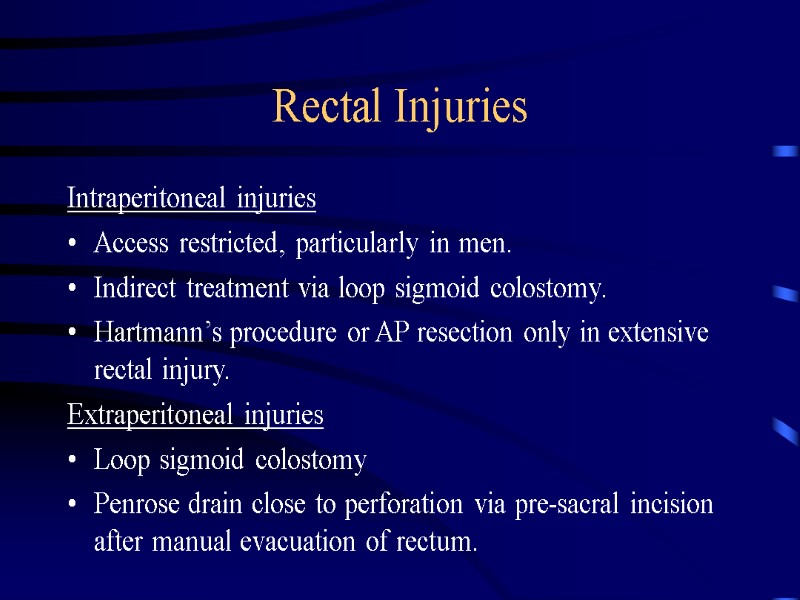
Rectal Injuries Intraperitoneal injuries Access restricted, particularly in men. Indirect treatment via loop sigmoid colostomy. Hartmann’s procedure or AP resection only in extensive rectal injury. Extraperitoneal injuries Loop sigmoid colostomy Penrose drain close to perforation via pre-sacral incision after manual evacuation of rectum.
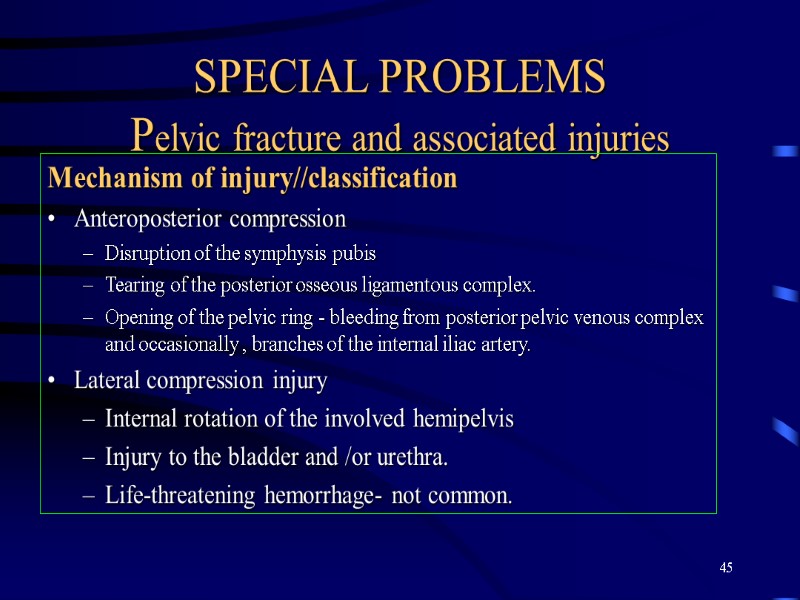
45 SPECIAL PROBLEMS Pelvic fracture and associated injuries Mechanism of injury//classification Anteroposterior compression Disruption of the symphysis pubis Tearing of the posterior osseous ligamentous complex. Opening of the pelvic ring - bleeding from posterior pelvic venous complex and occasionally , branches of the internal iliac artery. Lateral compression injury Internal rotation of the involved hemipelvis Injury to the bladder and /or urethra. Life-threatening hemorrhage- not common.
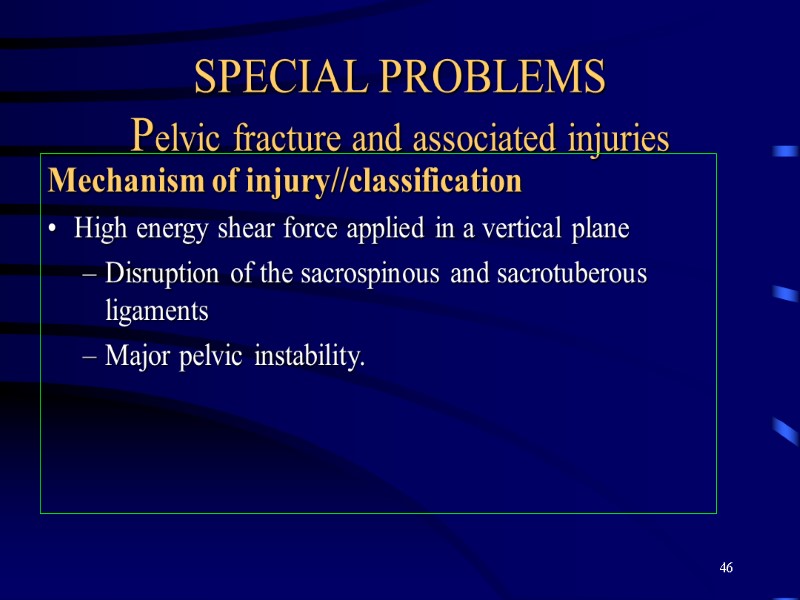
46 SPECIAL PROBLEMS Pelvic fracture and associated injuries Mechanism of injury//classification High energy shear force applied in a vertical plane Disruption of the sacrospinous and sacrotuberous ligaments Major pelvic instability.
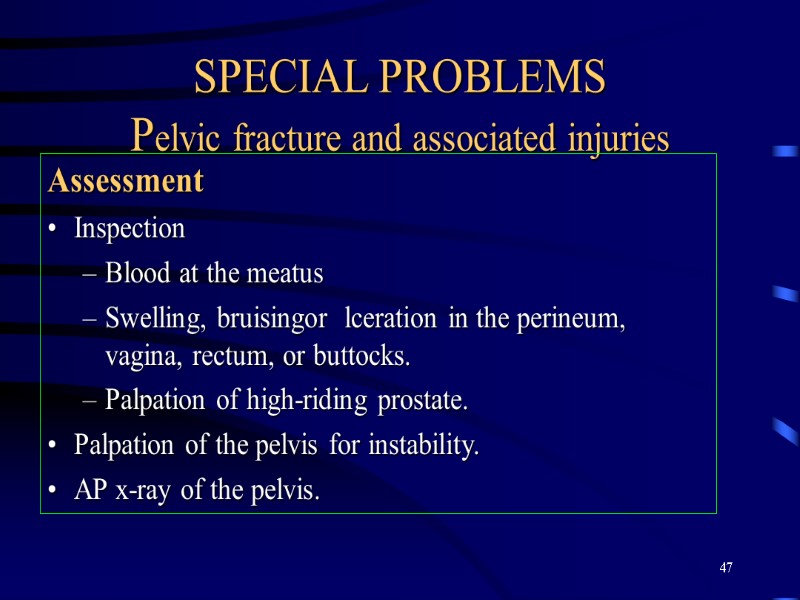
47 SPECIAL PROBLEMS Pelvic fracture and associated injuries Assessment Inspection Blood at the meatus Swelling, bruisingor lceration in the perineum, vagina, rectum, or buttocks. Palpation of high-riding prostate. Palpation of the pelvis for instability. AP x-ray of the pelvis.
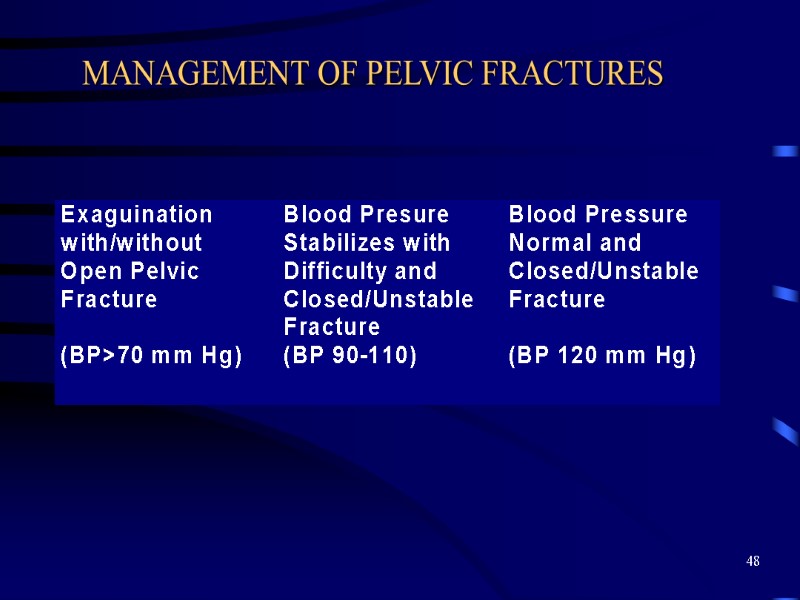
48 MANAGEMENT OF PELVIC FRACTURES

Impalement Injury
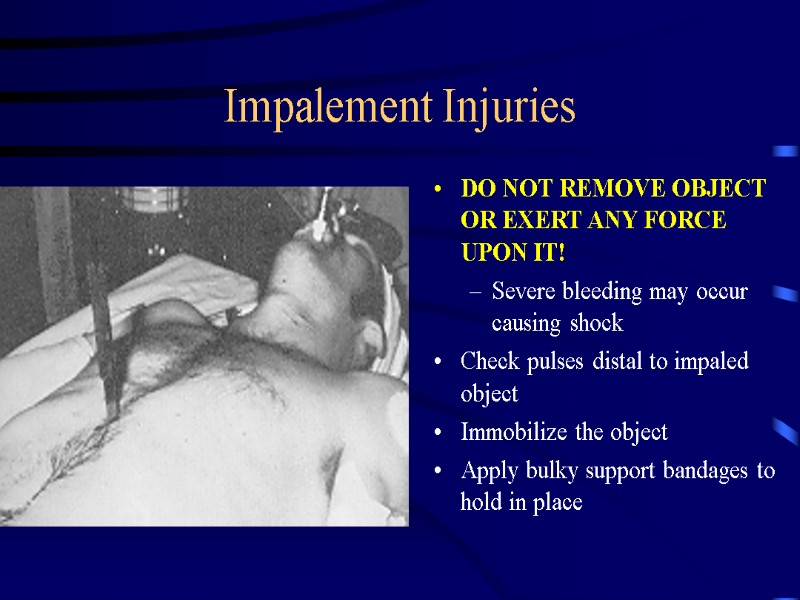
Impalement Injuries DO NOT REMOVE OBJECT OR EXERT ANY FORCE UPON IT! Severe bleeding may occur causing shock Check pulses distal to impaled object Immobilize the object Apply bulky support bandages to hold in place
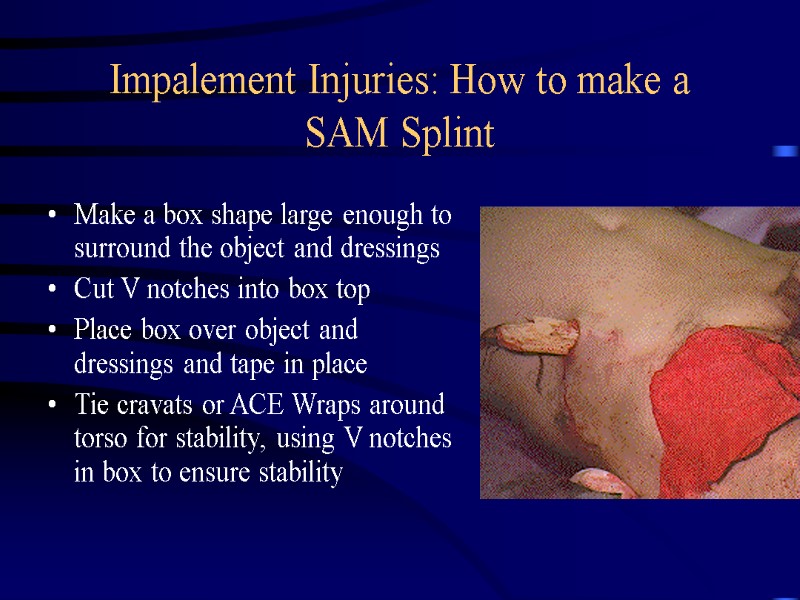
Impalement Injuries: How to make a SAM Splint Make a box shape large enough to surround the object and dressings Cut V notches into box top Place box over object and dressings and tape in place Tie cravats or ACE Wraps around torso for stability, using V notches in box to ensure stability
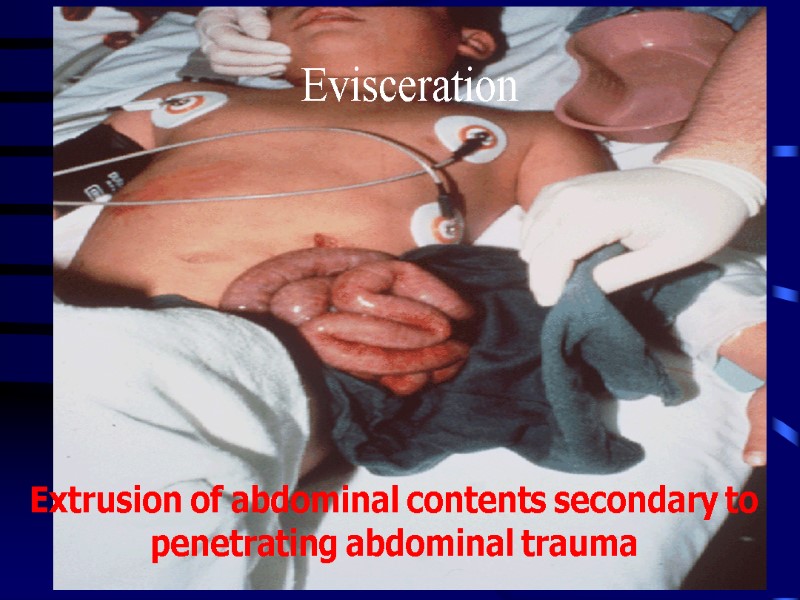
Evisceration Extrusion of abdominal contents secondary to penetrating abdominal trauma
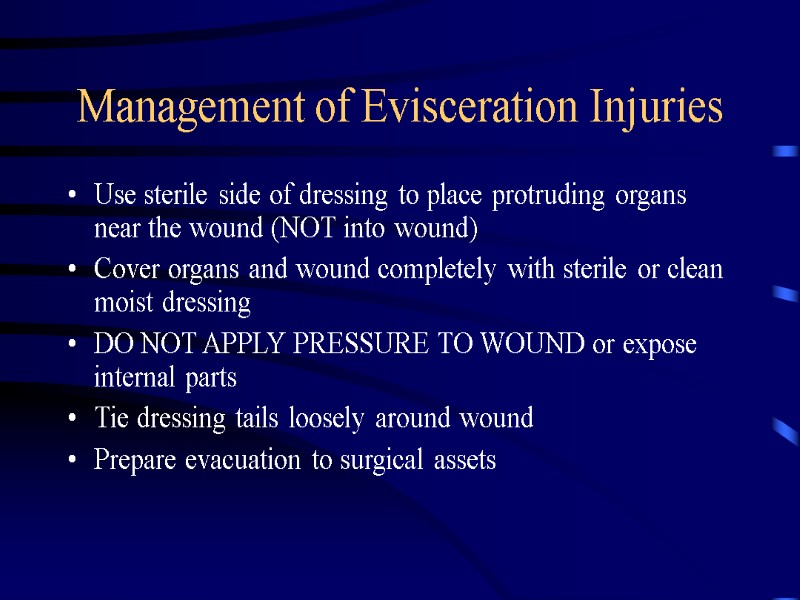
Management of Evisceration Injuries Use sterile side of dressing to place protruding organs near the wound (NOT into wound) Cover organs and wound completely with sterile or clean moist dressing DO NOT APPLY PRESSURE TO WOUND or expose internal parts Tie dressing tails loosely around wound Prepare evacuation to surgical assets
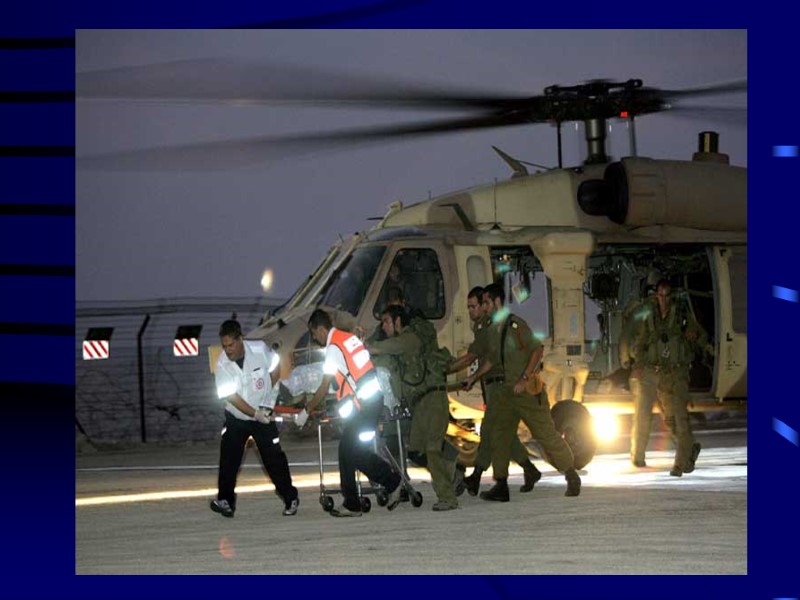
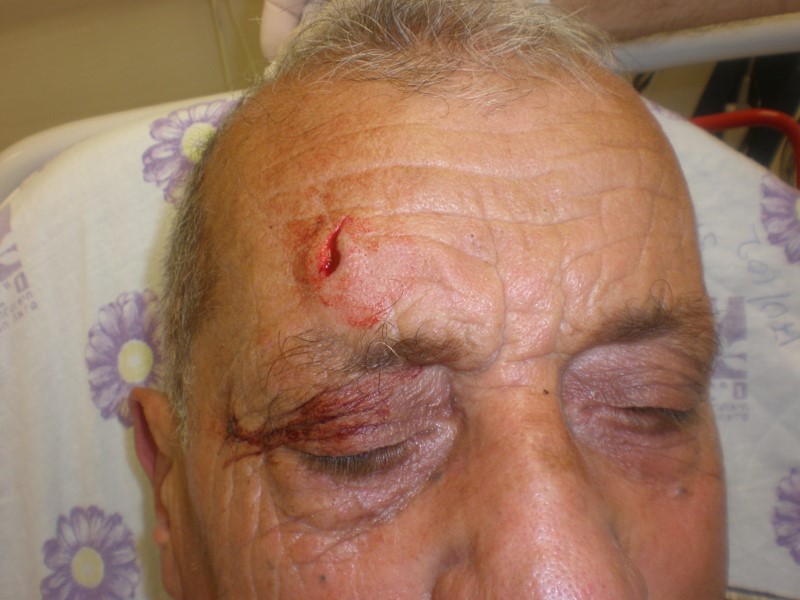
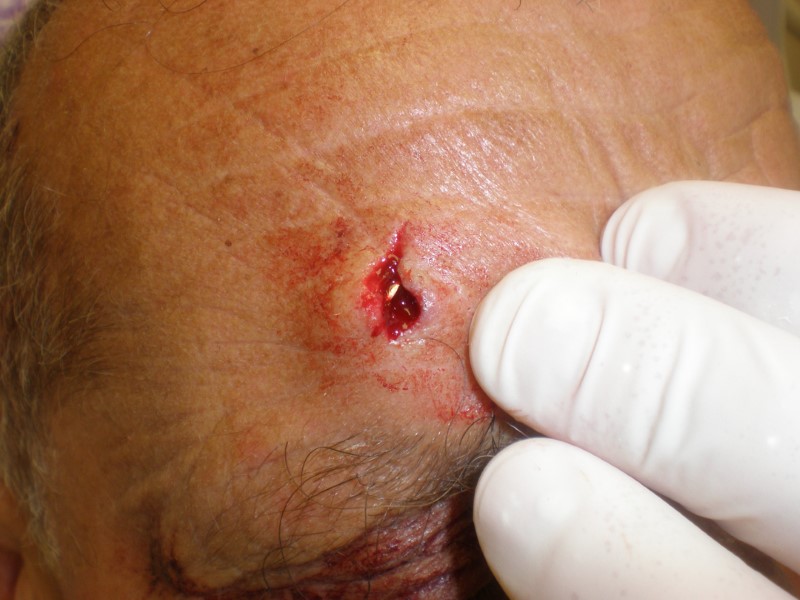

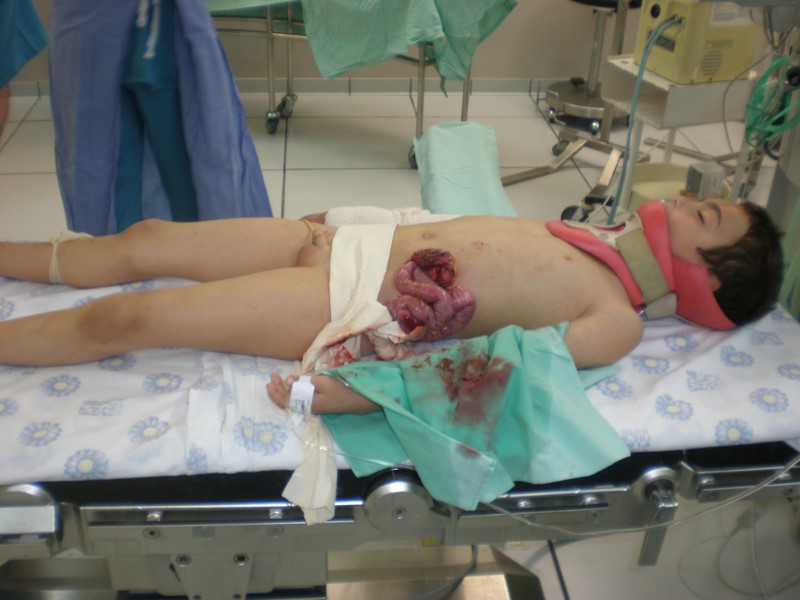
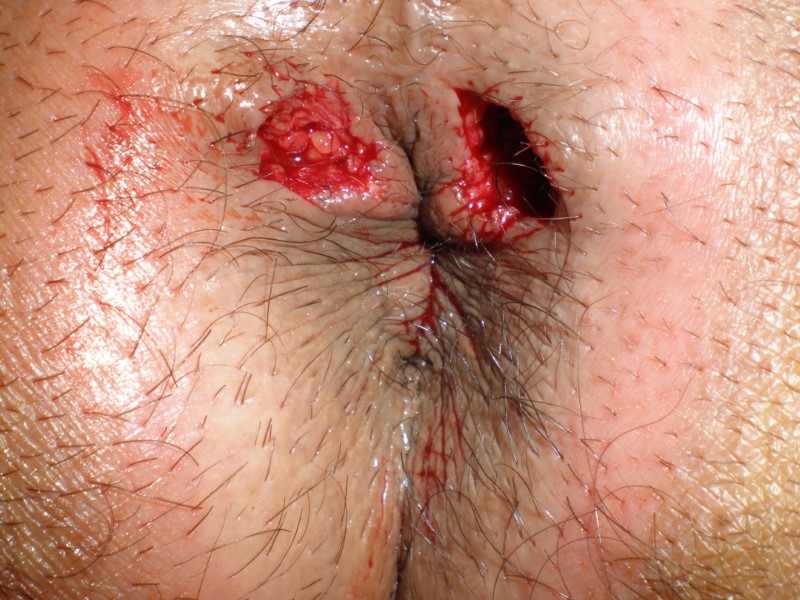
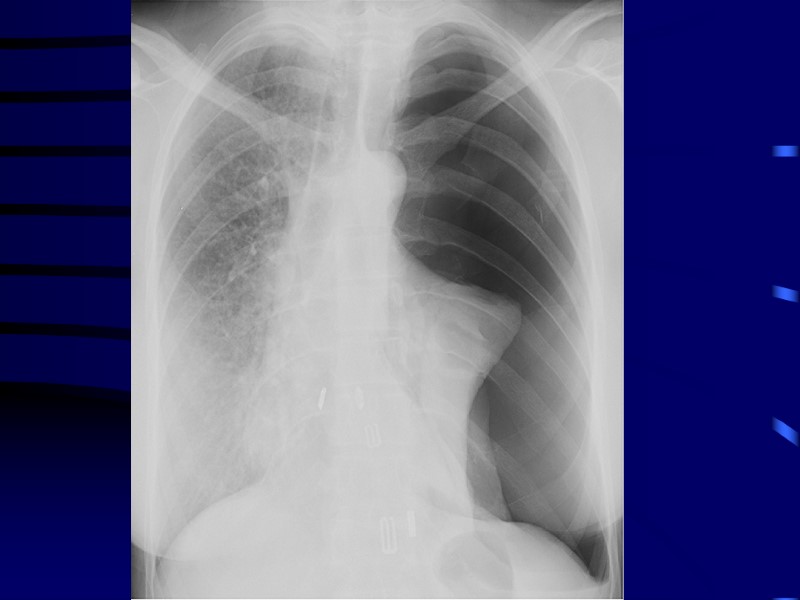
14868-abdominal_trauma_2011.ppt
- Количество слайдов: 60

